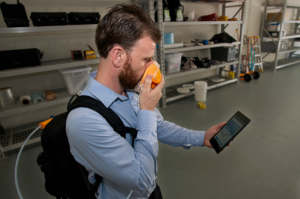 As an air quality expert, specialising in nuisance odours, I am often asked about the type of equipment we use to measure smells – and people are usually surprised by the answer. I can show clients a range of products for gathering and testing air samples, and all types of olfactometers for processing those samples – but people always ask where the tech is, what the software is for measuring the smells. Olfactometers are essentially just super clean air dilution devices for air samples – with lots of internal tubes and air ports coming out of them, and people assume that’s where they attach a computer. But no – that’s where people attach their faces, because the human nose is by far the most sensitive smell receptor that we have access to in the business. Noses are the only device that can really tell good smells from bad.
As an air quality expert, specialising in nuisance odours, I am often asked about the type of equipment we use to measure smells – and people are usually surprised by the answer. I can show clients a range of products for gathering and testing air samples, and all types of olfactometers for processing those samples – but people always ask where the tech is, what the software is for measuring the smells. Olfactometers are essentially just super clean air dilution devices for air samples – with lots of internal tubes and air ports coming out of them, and people assume that’s where they attach a computer. But no – that’s where people attach their faces, because the human nose is by far the most sensitive smell receptor that we have access to in the business. Noses are the only device that can really tell good smells from bad.That’s not to say that we don’t have digital monitors that can measure the presence of odorous compounds and other emissions in the air – but they are humble devices when compared with the combined intelligence of a human nose and brain. Our Pollutracker and Scentinal devices for example are electronic sensors that can measure pollutants in the air in real time, and that’s perfect when we’re talking about checking to see whether a client has exceeded a legal threshold of a certain emission. But a digital monitor can only measure the presence of an individual compound – it can’t tell us the compound’s hedonic tone (whether or not a human being would find the smell pleasant or not) and it can’t tell us what affect that smell will have on a community. That is why my team – all of whom have professionally calibrated noses, like wine-tasters calibrate their tongues – are out in the field every day, literally sniffing the air, and recording what we smell. Because a human nose can detect and identify a huge number of different smells that can be present at any one time, and a human brain can decide if that combination is likely to constitute a problem for the average person.
And when we’re talking about the smell of chicken farms or sewage treatment plants near a residential area, just measuring the concentration of each odour nearby is not enough, we need to measure their intensity – how they are perceived by humans. For example, without getting too technical, smells are typically measured in odour units (ou). And sometimes there are flat rules saying that no facility can cause a smell stronger than 2 ou at a place in the community that may be sensitive to an odour. However, this ignores people’s reaction to an odour. For example, an odour from a sewage plant that is 2 ou with a hydrogen sulfide character will be perceived by the community as completely different than an odour of 2 ou from a biofilter that has a soil/bark, earthy character. The intensity and hedonic tone of an odour are everything – it’s the difference between walking into a florist or a bakery and walking into a dirty public bathroom. The odour in both environments could measure 2 ou but be perceived very differently. Which one would you prefer?
That is why at Air Environment, our approach is always to gather more than just the digitally measured concentration levels of an odour. We know that not all odours are experienced in the same way, so to really assess nuisance odour, particularly in terms of annoyance to the community, you need the best tool available – your nose.











